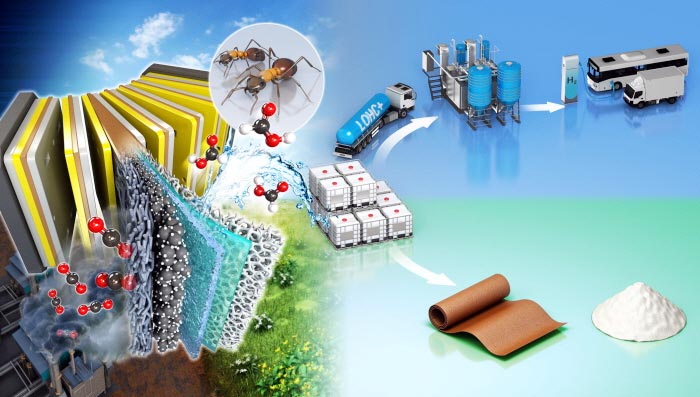CO2→ formate conversion technology

Production and utilization of formate with fluorine-doped tin oxide catalyst for CO2 conversion
Credit: Korea Institute of Science and Technology (KIST)
… with significantly improved production rate.
Enhancement four times the conventional production rate, 100 times the durability compared to conventional commercial electrodes. High potential use for LOHC hydrogen reservoir.
“Carbon dioxide as a resource” and “hydrogen energy utilization” are considered to be the most practical measures to realize carbon neutrality. However, technological innovation is essential for them to be feasible both environmentally and economically. To this end, a Korean research team developed a proprietary technology that harnesses the synergy of both fields: “carbon dioxide as a resource” and “hydrogen energy utilization.”
The Korea Institute of Science and Technology (KIST; President: Seok-Jin Yoon) reported that the research group of Dr. Hyung-Suk Oh at the Clean Energy Research Center has developed a technology that stably converts carbon dioxide into useful liquid compounds (formate) by performing high-volume synthesis with fluorine-doped tin oxide catalysts. Also called methanoic acid, formate is a basic chemical raw material used in various industries such as food processing, preservatives, dyeing agents, plasticizers, snow removal agents, and cure retardants owing to its distinctive sour taste, anti-bacterial properties, and its ability to control pH. In recent years, it has also been in the spotlight as a raw material for eco-friendly biodegradable plastic.
Because most formate is currently produced via the thermo-chemical reaction of fossil fuels, carbon dioxide emissions are inevitable during the manufacturing process. While it can be manufactured in an eco-friendly manner if carbon dioxide is directly converted into formate via an electro-chemical reaction, it would be necessary to increase electrode material performance responsible for converting the gas to a liquid phase, and to ensure durability, which allows electrodes to function stably for a long time.
The KIST research team focused on the fact that fluorine-doped tin oxide has a lower tendency than regular tin oxide to metalize and maintain the carbon dioxide conversion activity of catalysts. By using a relatively simple method of doping fluorine during the synthesis of Tin oxide, the researchers developed an electrode that maintains high formate conversion activity in a stable manner. The fluorine-doped tin oxide electrode manufactured by the proposed method was shown to have a formate production rate that is four times that of an existing commercial tin oxide electrode, and its durability improved by at least 100 times, so its performance is maintained even during a long-term reaction time of over a week.
Alternatively, formate is one of the most promising candidates as a liquid organic hydrogen carrier (LOHC), which is a hydrogen storage material that bonds hydrogen with a third substance to enable storage and transportation without the need to rely on expensive heavy-duty specialized containers. The core of LOHC technology is to secure liquefied compounds with high storage capacity for hydrogen and safety, even when exposed to external factors; formate has this characteristic. With the application of the technology developed by the researchers, as the environmental and economic concerns (which were previously considered weaknesses) will be resolved simultaneously, a reevaluation of its competitiveness is expected against other candidate materials such as ammonia.
According to Dr. Hyung-Suk Oh, “By developing highly efficient electrodes, we can build a continuous system mass-producing formate from carbon dioxide.” “Not only is this a direction for Carbon Capture, Utilization and Storage (CCUS), but also it is a “killing two birds in one stone” kind of technology that provides large amount of formate ideal for hydrogen storage. We expect it to contribute greatly to carbon neutrality in the future as the renewable energy supply increases and the hydrogen-based society advances, making the system economically feasible.”
KIST was established in 1966 as the first government-funded research institute in Korea to establish a national development strategy based on science and technology and disseminate various industrial technologies to promote the development of major industries. KIST is now elevating the status of Korean science and technology through the pursuit of world-leading innovative research and development. For more information, please visit KIST’s website at https://eng.kist.re.kr/
This research was supported by the Ministry of Science and ICT (Minister: Dr. Jong-Ho Lee) and was carried out as the “KIST Institutional Program,” “Carbon to X Project,” and “Creative Convergence Research Project”. The research was published in the latest issue of “Nature Communications,” which is a renowned international journal (IF: 14.919, JCR high categorical rank 4.861%).
Journal: Nature Communications
DOI: 10.1038/s41467-022-29783-7
Article Title: Exploring dopant effects in stannic oxide nanoparticles for CO2 electro-reduction to formate
Article Publication Date: 22-Apr-2022
All latest news from the category: Life Sciences and Chemistry
Articles and reports from the Life Sciences and chemistry area deal with applied and basic research into modern biology, chemistry and human medicine.
Valuable information can be found on a range of life sciences fields including bacteriology, biochemistry, bionics, bioinformatics, biophysics, biotechnology, genetics, geobotany, human biology, marine biology, microbiology, molecular biology, cellular biology, zoology, bioinorganic chemistry, microchemistry and environmental chemistry.
Newest articles

A universal framework for spatial biology
SpatialData is a freely accessible tool to unify and integrate data from different omics technologies accounting for spatial information, which can provide holistic insights into health and disease. Biological processes…

How complex biological processes arise
A $20 million grant from the U.S. National Science Foundation (NSF) will support the establishment and operation of the National Synthesis Center for Emergence in the Molecular and Cellular Sciences (NCEMS) at…

Airborne single-photon lidar system achieves high-resolution 3D imaging
Compact, low-power system opens doors for photon-efficient drone and satellite-based environmental monitoring and mapping. Researchers have developed a compact and lightweight single-photon airborne lidar system that can acquire high-resolution 3D…





















